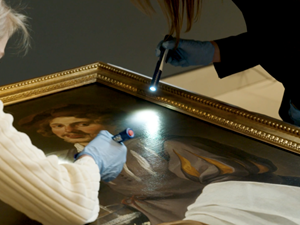
Flemish art, makes clear the role of the museum curator has fundamentally changed in recent decades. The task of the curator is shifting steadily from keeper of the collection and researcher in the direction of networker and narrator.
Although the basics of the discipline have not changed essentially, the way curators have to carry out their work has. Curators have been found to be able to fulfil a decisive role in the area of change and innovation within museums. The results of the research are being revealed today during a symposium on the occasion of CODART’s 25th anniversary. Never before has this ‘19th-century discipline’ been so rigorously investigated.
What is the role – and what is the value – of the curator of Dutch and Flemish art in today’s museum? And what does the future hold? These were key questions for the extensive research CODART had carried out by an external research bureau on the occasion of its 25th anniversary. The research focuses on the curator of Dutch and Flemish art, before 1800, CODART’s membership, but the findings may also be valid for curators with other specializations. On the basis of quantitative and qualitative data, the bureau analysed changes in the world of museums and the role of the curator, nationally in particular and internationally when possible. This has led to a number of conclusions and recommendations, forming the basis for subsequent discussion and research.

Maartje Beekman, CODART director: “As an international network of curators of Dutch and Flemish art before 1800, we are continuously aware of the development of the discipline of curator. We have seized the opportunity of our 25th anniversary to gain insight into the present state of the profession and provide a glimpse of the future. The research shows how crucial the role of the curator in a museum is, but also the great importance of remaining vigilant of the curator’s core responsibilities. We consider it to be an important mission to make widely known the importance of these museum professionals.”
We live in a world of rapid change, constantly confronting museums with new challenges. Museums are no longer merely places to conserve and curate; they play an increasingly important role in society. They are places where stories are told, places for reflection, for exchanging views and experiences, and for research. In short, museums are continuously changing, as is the world around them. They also play a critical role as institutions providing reliable information. The curator plays a central role in this process of assembling and disseminating knowledge.
At the same time, the role of the museum curator has changed tremendously in recent decades. The relationship with the public, for example, plays a more prominent role in museum policy and there is a trend towards more cooperation with other disciplines and organizations, which has a large impact on the role (or the perception of the role) of the curator. Networking and narrating relevant stories seem to be becoming increasingly important skills. Today’s curator must, in other words, command a wider range of professional skills than in the past. This expanding job description is inevitably leading to a shift of focus, which can come at the cost of the core responsibilities, specifically the development of knowledge through research into and the curation of art collections.
The developments above invoke important follow-up questions and recommendations that both educational programmes and museums should address. How to develop a sound educational programme, well suited to working in the field, for example? How to deal with issues like gaining experience, collaborating and networking, and developing expertise? And how to manage all of these activities and expectations effectively?CODART has also developed a series of 25 short clips on the essential skills of the museum curator. Several curators are featured in these clips.
CODART is the international network of curators of Dutch and Flemish art. With over 700 members worldwide, CODART connects a large number of specialists and in this way, contributes to the international exchange of knowledge, the curation of our shared heritage and the organization of exhibitions and research projects in the field of Flemish and Dutch art from the 15th until the 19th century. CODART – in cooperation with its members and the wider public – published the CODART Canon in 2019, an overview of 100 masterpieces from Flemish and Dutch art before 1800.

ArtDependence Magazine is an international magazine covering all spheres of contemporary art, as well as modern and classical art.
ArtDependence features the latest art news, highlighting interviews with today’s most influential artists, galleries, curators, collectors, fair directors and individuals at the axis of the arts.
The magazine also covers series of articles and reviews on critical art events, new publications and other foremost happenings in the art world.
If you would like to submit events or editorial content to ArtDependence Magazine, please feel free to reach the magazine via the contact page.